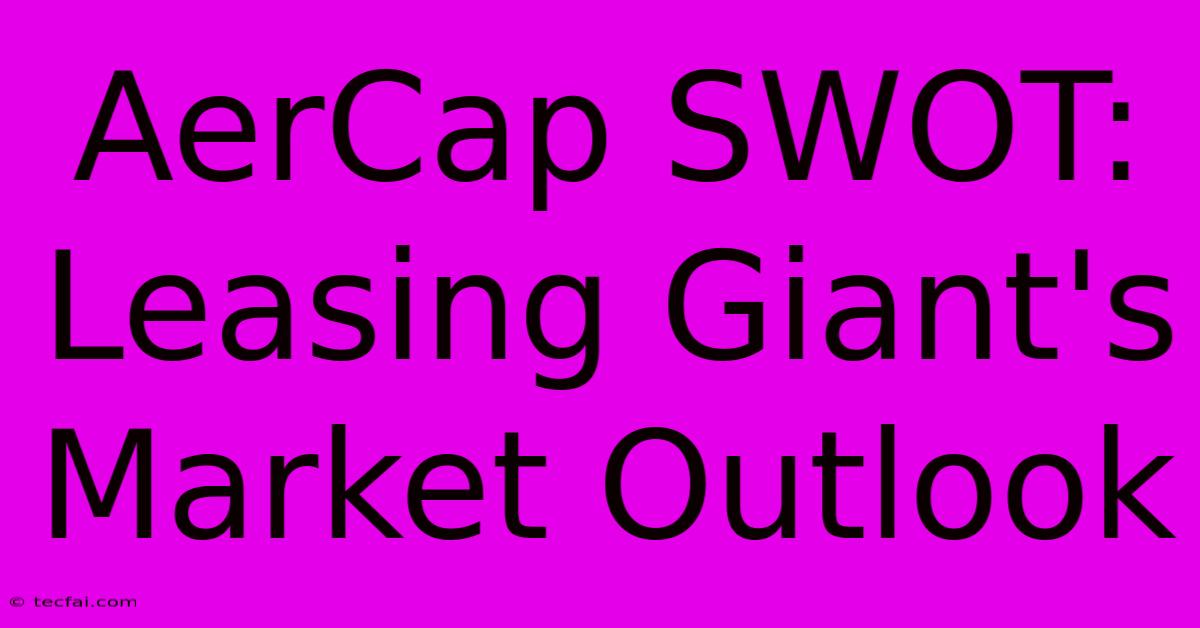AerCap SWOT: Leasing Giant's Market Outlook

Discover more detailed and exciting information on our website. Click the link below to start your adventure: Visit Best Website tecfai.com. Don't miss out!
Table of Contents
AerCap SWOT: Leasing Giant's Market Outlook
AerCap Holdings N.V. (AER) is a leading global aircraft leasing company with a diverse portfolio of aircraft. As the aviation industry navigates a post-pandemic recovery, understanding AerCap's strengths, weaknesses, opportunities, and threats (SWOT) is crucial for investors and stakeholders.
Strengths
- Dominant Market Position: AerCap is the world's largest aircraft leasing company, boasting a fleet of over 2,000 aircraft and a strong market presence. This size and scale provide leverage in negotiating lease terms and securing favorable deals.
- Diversified Portfolio: AerCap's portfolio comprises a wide range of aircraft types, including narrow-body, wide-body, and regional jets. This diversification mitigates risks associated with specific aircraft models or market segments.
- Strong Financial Position: AerCap enjoys a robust financial position, with a strong balance sheet and access to capital markets. This allows for ongoing investments and expansion even in challenging economic conditions.
- Technological Expertise: AerCap is at the forefront of innovation, investing in technology to optimize its operations, improve fleet management, and enhance customer service.
- Experienced Management Team: AerCap's leadership boasts extensive industry expertise, enabling the company to navigate complex market dynamics and adapt to changing industry trends.
Weaknesses
- High Debt Levels: AerCap's large fleet comes with significant debt obligations. While manageable in stable market conditions, elevated interest rates or economic downturns could strain its financials.
- Competition: The aircraft leasing market is increasingly competitive, with new players entering the scene and established competitors expanding their operations.
- Dependence on Airline Industry: AerCap's revenue stream is directly linked to the health of the airline industry. Economic instability, geopolitical events, or unforeseen crises could negatively impact demand for aircraft leasing.
- Regulatory Landscape: The aviation industry is subject to complex and evolving regulations, which could pose challenges for AerCap in terms of compliance and operational efficiency.
Opportunities
- Growing Global Demand: The aviation industry is expected to experience steady growth in the coming years, driven by rising passenger demand and increasing air travel. This presents a significant opportunity for AerCap to expand its fleet and lease agreements.
- Emerging Markets: Developing economies are witnessing rapid air travel growth, creating new markets for aircraft leasing. AerCap can capitalize on these opportunities by expanding its operations in these regions.
- Sustainability Focus: The industry is shifting towards sustainability, with airlines adopting fuel-efficient aircraft and exploring alternative fuel sources. AerCap can position itself as a leader in sustainable leasing by offering eco-friendly aircraft and supporting green initiatives.
- Digital Transformation: Adopting new technologies and embracing digital solutions can streamline operations, enhance customer experience, and drive cost efficiencies. AerCap can gain a competitive edge by investing in digital transformation.
Threats
- Economic Recession: A global economic downturn could significantly impact airline profitability and reduce demand for aircraft leasing, potentially leading to lower utilization rates and revenue for AerCap.
- Geopolitical Instability: Ongoing geopolitical tensions and conflicts can disrupt global travel patterns and create uncertainty in the aviation industry, impacting AerCap's business.
- Technological Disruptions: New technologies, such as electric and autonomous aircraft, could eventually disrupt the traditional aviation industry, presenting potential challenges for AerCap's business model.
- Environmental Regulations: Stricter environmental regulations could increase operating costs for airlines, potentially leading to reduced demand for aircraft leasing.
Conclusion
AerCap holds a strong market position and possesses significant potential for growth in the coming years. However, the company must navigate several challenges, including high debt levels, intense competition, and economic uncertainties. By leveraging its strengths, capitalizing on opportunities, and mitigating potential threats, AerCap can continue to thrive in the evolving aviation landscape. Investors and stakeholders should closely monitor AerCap's performance and its ability to adapt to changing market dynamics.

Thank you for visiting our website wich cover about AerCap SWOT: Leasing Giant's Market Outlook. We hope the information provided has been useful to you. Feel free to contact us if you have any questions or need further assistance. See you next time and dont miss to bookmark.
Featured Posts
-
Trump Presidency Benefits For Elon Musk
Nov 07, 2024
-
The Handmaids Tale 1984 Back On Bestseller List
Nov 07, 2024
-
Hugging Face Samba Nova One Click Chatbots
Nov 07, 2024
-
Celtics Vs Warriors Odds Line Score
Nov 07, 2024
-
Asda Job Cuts Three Day Office Policy
Nov 07, 2024
